
Sir Harry James Veitch was an eminent English horticulturist in the nineteenth century, who was the head of the family nursery business, James Veitch & Sons, based in Chelsea, London. He was instrumental in establishing the Chelsea Flower Show, which led to him being knighted for services to horticulture.

Begonia grandis, the hardy begonia, is a species of flowering plant in the family Begoniaceae. This herbaceous perennial has alternate, simple leaves on arching stems. The flowers are pink or white, borne in dichotomously branching cymes from late summer through fall in USDA U.S. Hardiness Zone 7. As the common name "hardy begonia" implies, it is winter hardy in some temperate regions.
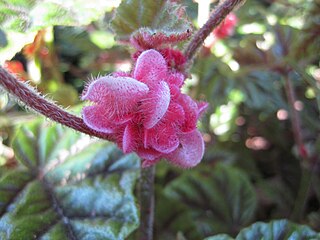
Begonia incarnata is a species of plant in the family Begoniaceae, native to Brazil. It is a shrublike evergreen perennial growing to 1 metre (39 in), bearing large, asymmetrical green leaves with a metallic sheen, and dark green veins. It produces small hairy pink flowers. As it does not tolerate temperatures below 10 °C (50 °F), in temperate regions it must be grown under glass.
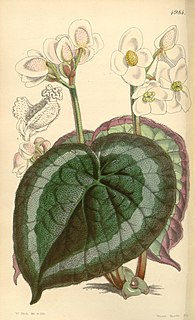
Begonia annulata, the ringed begonia, is a species of flowering plant in the genus Begonia native to the eastern Himalaya, Bangladesh, Assam in India, Myanmar, and Vietnam. It has gained the Royal Horticultural Society's Award of Garden Merit.
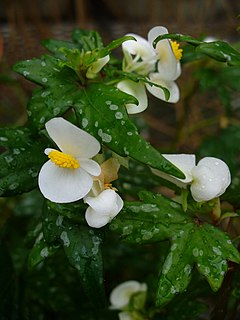
Begonia dregei, the maple leaf begonia or grape-leaf begonia, is a species of flowering plant in the genus Begonia native to South Africa. It has gained the Royal Horticultural Society's Award of Garden Merit.

Begonia imperialis, the imperial begonia, is a species of flowering plant in the genus Begonia, native to southern Mexico and Guatemala. It has gained the Royal Horticultural Society's Award of Garden Merit.

Begonia luxurians, the palm leaf begonia, is a species of flowering plant in the genus Begonia, native to southeastern Brazil. It has gained the Royal Horticultural Society's Award of Garden Merit.

Begonia radicans, the shrimp begonia, is a species of flowering plant in the genus Begonia, native to southeastern and southern Brazil. It has gained the Royal Horticultural Society's Award of Garden Merit.
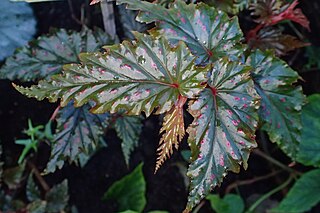
Begonia serratipetala is a species of flowering plant in the genus Begonia, native to New Guinea. It has gained the Royal Horticultural Society's Award of Garden Merit.
Begonia solananthera, the Brazilian heart begonia, is a species of flowering plant in the genus Begonia, native to southeastern Brazil. It has gained the Royal Horticultural Society's Award of Garden Merit.
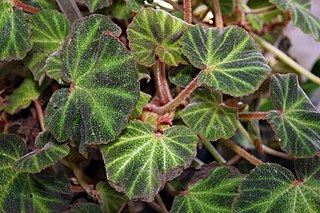
Begonia solimutata, the sun-changing begonia, is a species of flowering plant in the family Begoniaceae, native to Pará state in northern Brazil. It has gained the Royal Horticultural Society's Award of Garden Merit.

Begonia rex, the king begonia, is a species of flowering plant in the family Begoniaceae. It is found from Arunachal Pradesh to southeast China, and has been introduced to Bangladesh, Cuba, and Hispaniola. It is a parent to over 500 cultivars in the Begonia Rex Cultorum Group of houseplants. Other parents in the multitude of crosses made during the creation of the Group include Begonia annulata, B. cathayana, B. decora, B. diadema, B. dregei, B. grandis, B. hatacoa, B. palmata, and B. xanthina.

Begonia heracleifolia, the star begonia, is a species of flowering plant in the family Begoniaceae. It is native to Mexico and northern Central America, and has been introduced to Cuba, Hispaniola, Puerto Rico, and Trinidad and Tobago. A widespread species that is adapted to drought, it possesses considerable genetic and morphological variation, particularly in leaf shape and patterning.
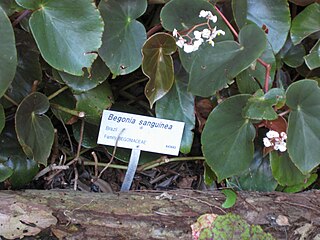
Begonia sanguinea, the beefsteak begonia or blood-red begonia, is a species of flowering plant in the family Begoniaceae, native to southern Brazil. Valued for the deep red color of the abaxial surface of their leaves, they are easy to propagate from cuttings.

Begonia ulmifolia, the elm-leaf begonia, is a species of flowering plant in the family Begoniaceae. It is native to South America; Trinidad and Tobago, Venezuela, the Guianas, and eastern Brazil, and introduced to Mauritius, Réunion, and the Seychelles in the Indian Ocean. Cultivated for its ornamental foliage more than its flowers, it is suitable for green roofs in hot and humid areas.

Begonia bowerae, the eyelash begonia, is a species of flowering plant in the family Begoniaceae, native to Oaxaca and Chiapas states of Mexico. A popular houseplant, a number of cultivars are available.
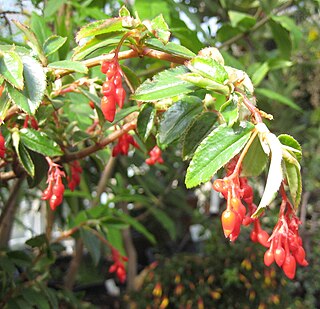
Begonia fuchsioides, the fuchsia begonia, is a species of flowering plant in the family Begoniaceae. It is native to Ecuador, Colombia, and western Venezuela, and has been introduced to Hawaii and Réunion. A small bush reaching 2 ft (60 cm), it is hardy to USDA zone 10a.
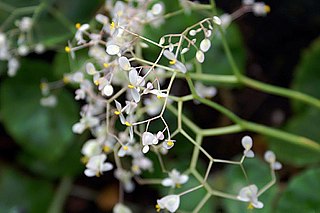
Begonia manicata is a species of flowering plant in the family Begoniaceae, native to Mexico and Central America. The cultivar 'Aureo-maculata' is called the leopard begonia.
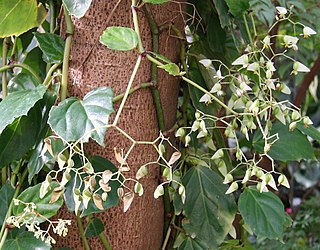
Begonia glabra, the climbing sorrel, is a species of flowering plant in the family Begoniaceae, native to the New World Tropics. An unusual vining begonia, it is popular in vivariums. Its use in the Winti Afro-Surinamese traditional religion has led to local over-collection.
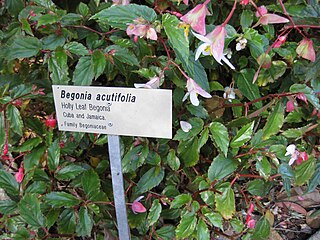
Begonia acutifolia, the holly-leaf begonia, is a species of flowering plant in the family Begoniaceae, native to Cuba and Jamaica, and introduced to Saint Helena. Shade tolerant, it is kept as a house plant, or outside in USDA hardiness zone 9b or warmer.




















